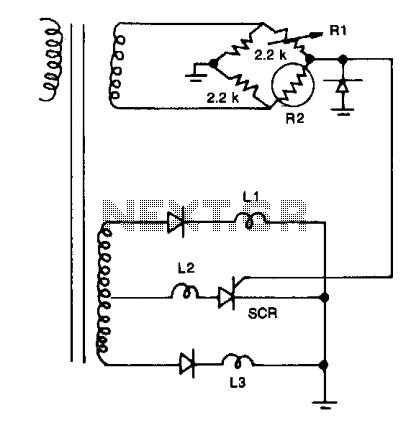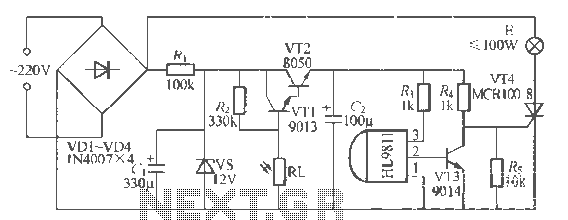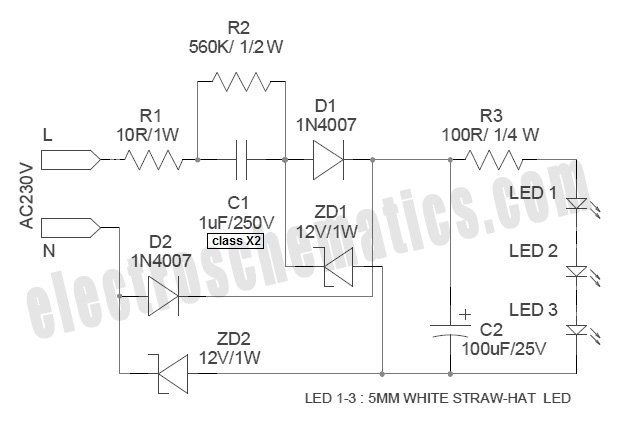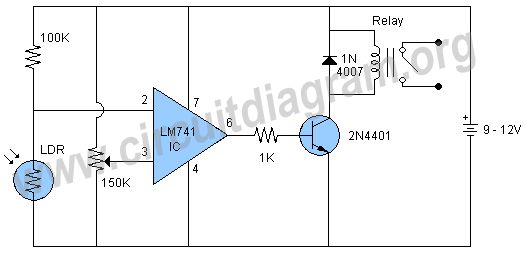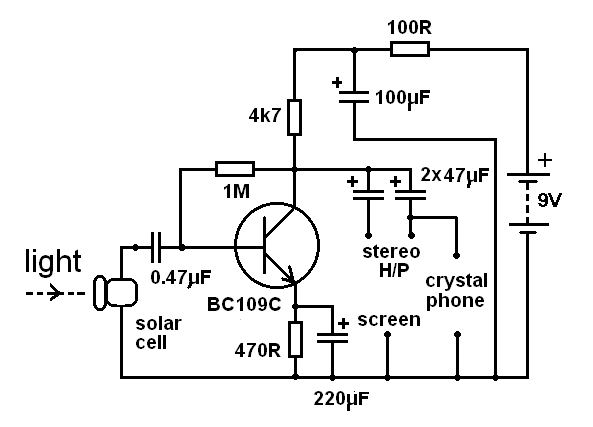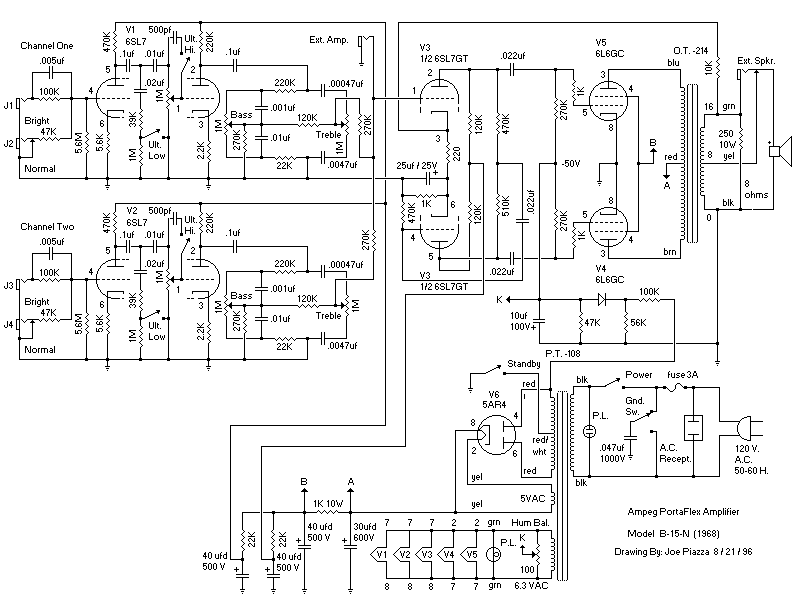
Security Light & Switch with PIR Sensor Update
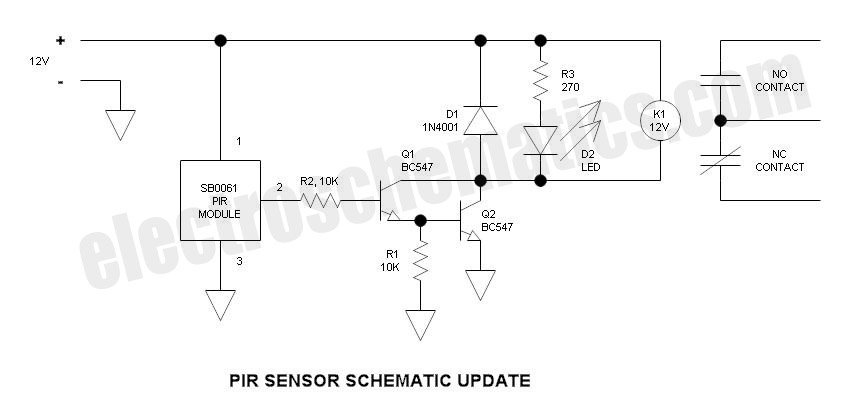
This is an update to Mr. Hareendran's PIR Sensor Security Light circuit. It has a limitation that restricts the relay voltage to approximately 3.3V. While this may work with some 5V relays, it is not compatible with all. The design of an emitter follower Darlington configuration causes the output voltage to be two junction drops below the base drive voltage, plus a minor voltage drop across R1. In alignment with the original design, the Darlington arrangement and transistor type number were retained; however, the transistors were changed from a common collector to a common emitter configuration, with the relay connected between the collector output and the positive rail. The relay now uses a 12V coil. To utilize an existing 5V relay, a resistor should be added in series with the coil, scaled up from the coil resistance. Additionally, the LED was connected across the relay coil instead of being powered through the second relay contact, which simplifies the design to require only one form C relay contact, thereby reducing costs. Some unnecessary components were eliminated. When motion is detected, the output (pin 2) goes to 5V, allowing current to flow through R2 to the base of Q1. The emitter current of Q1 serves as the base current for Q2. The current gain of a Darlington configuration is typically squared (hFE), resulting in a gain of approximately 10,000 to 50,000, providing sufficient drive current for the relay. R1 allows for conducting any potential leakage in Q1 to common and assists in turning off Q2 more quickly. D1 is a back diode that circulates the relay coil current when Q1 and Q2 turn off, preventing damaging voltage transients. The circuit has not been built and tested, but it is expected to function correctly based on experience. The supply voltage ranges from 5 to 20V, as indicated by the SB0061 module specifications and the BISS0001 IC application example. It is common for such modules to include a 7805L voltage regulator, although there is some confusion regarding operation at 5V due to the dropout voltage of the regulator, which may reduce the regulated voltage to approximately 3.5V. Therefore, it is advisable to operate the circuit at 9 to 12V. There is no standard 5V battery available. A suggestion for future consideration is to publish a DIY circuit for the PIR sensor, as it would be a significant component of a PIR circuit.
The described circuit utilizes a PIR (Passive Infrared) sensor to detect motion and activate a relay-based lighting system. The change from a common collector to a common emitter configuration enhances the voltage output capability, allowing for better compatibility with higher-voltage relays. By employing a 12V relay coil, the circuit can be more effectively integrated into existing systems that may utilize higher voltage supplies, while still accommodating lower voltage relays with the appropriate resistor in series to limit current.
The use of a Darlington pair (Q1 and Q2) provides a high current gain, which is beneficial for driving the relay without requiring a significant input current. The design also incorporates a back diode (D1) to protect against voltage spikes caused by the relay coil's inductive load when the relay is deactivated. This is a critical aspect of relay design, as it ensures the longevity of the transistors and other components in the circuit.
The choice of resistors (R1 and R2) is essential for proper biasing and stability of the transistor stages. R1 not only helps with leakage current management but also plays a role in the turn-off characteristics of Q2, which is vital for ensuring that the relay does not chatter or respond erratically to transient signals. R2 controls the base current to Q1, thus influencing the overall sensitivity of the motion detection.
The recommended operating voltage range (9 to 12V) is practical, as it provides ample headroom above the dropout voltage of the regulator, ensuring consistent performance of the entire circuit. Overall, this updated design presents a more robust solution for motion-activated lighting, with considerations made for component selection and circuit efficiency. Future iterations could explore additional features such as adjustable sensitivity or integrated timers to enhance functionality.This is a simple update to Mr. Hareendran`s PIR Sensor Security Light circuit. It has a shortcoming limits the relay voltage to approximately 3. 3V. While this may function with some 5V relays, it will not function with all. The nature of an emitter follower Darlington forces the output voltage to be two junction drops below the base drive voltage plus a small voltage drop across R1. In keeping with the spirit of his design, I retained the Darlington arrangement, and the transistor type number however, I changed the transistors from common collector to common emitter configuration, and connected the relay between the collector output and the positive rail. The relay now utilizes a 12V coil to use an existing 5V relay, simply add a resistor in series with the coil whose value is scaled up from the coil resistance.
Also, I connected the LED across the relay coil rather than powering it via the 2nd relay contact this way, only one form C relay contact is required thus making the relay less expensive of course it can be done either way. I eliminated some additional, unneeded components. When motion is detected, the output (pin 2) goes to 5V and current flows through R2 to the base of Q1.
The emitter current of Q1 becomes the base current of Q2 the current gain of a Darlington is the hFE squared or about 10, 000 to 50, 000 (very high). This easily provides adequate drive current for the relay. R1 provides a means of conducting any potential leakage in Q1 to common and also helps Q2 to turn off faster.
D1 is the back diode that circulates the relay coil current when Q1 & Q2 turns off thus preventing a damaging voltage transient. No, I did not build and test this one I just happen to know from experience that this circuit will work OK if the circuit was new to me, I would definitely Protoboard and test because Murphy may be lurking somewhere.
Murphy`s Law states that anything that can go wrong will go wrong Such is true as I have proven it numerous times. Supply voltage is roughly 5 to 20V as indicated by both the SB0061 module specifications and the BISS0001 IC application example.
I believe that it is typical for such modules to include a 7805L voltage regulator. The only confusion factor is how it works at 5V due to the drop-out voltage of the voltage regulator. This would reduce the regulated voltage to perhaps 3. 5V or so. As a result, I would recommend simply running it at 9 to 12V. Also, there is no standard 5V battery. I was just wondering that maybe in the future, you could publish a DIY circuit about the PIR sensor, It would be interesting, since it would the a major part of a PIR circuit.
🔗 External reference
The described circuit utilizes a PIR (Passive Infrared) sensor to detect motion and activate a relay-based lighting system. The change from a common collector to a common emitter configuration enhances the voltage output capability, allowing for better compatibility with higher-voltage relays. By employing a 12V relay coil, the circuit can be more effectively integrated into existing systems that may utilize higher voltage supplies, while still accommodating lower voltage relays with the appropriate resistor in series to limit current.
The use of a Darlington pair (Q1 and Q2) provides a high current gain, which is beneficial for driving the relay without requiring a significant input current. The design also incorporates a back diode (D1) to protect against voltage spikes caused by the relay coil's inductive load when the relay is deactivated. This is a critical aspect of relay design, as it ensures the longevity of the transistors and other components in the circuit.
The choice of resistors (R1 and R2) is essential for proper biasing and stability of the transistor stages. R1 not only helps with leakage current management but also plays a role in the turn-off characteristics of Q2, which is vital for ensuring that the relay does not chatter or respond erratically to transient signals. R2 controls the base current to Q1, thus influencing the overall sensitivity of the motion detection.
The recommended operating voltage range (9 to 12V) is practical, as it provides ample headroom above the dropout voltage of the regulator, ensuring consistent performance of the entire circuit. Overall, this updated design presents a more robust solution for motion-activated lighting, with considerations made for component selection and circuit efficiency. Future iterations could explore additional features such as adjustable sensitivity or integrated timers to enhance functionality.This is a simple update to Mr. Hareendran`s PIR Sensor Security Light circuit. It has a shortcoming limits the relay voltage to approximately 3. 3V. While this may function with some 5V relays, it will not function with all. The nature of an emitter follower Darlington forces the output voltage to be two junction drops below the base drive voltage plus a small voltage drop across R1. In keeping with the spirit of his design, I retained the Darlington arrangement, and the transistor type number however, I changed the transistors from common collector to common emitter configuration, and connected the relay between the collector output and the positive rail. The relay now utilizes a 12V coil to use an existing 5V relay, simply add a resistor in series with the coil whose value is scaled up from the coil resistance.
Also, I connected the LED across the relay coil rather than powering it via the 2nd relay contact this way, only one form C relay contact is required thus making the relay less expensive of course it can be done either way. I eliminated some additional, unneeded components. When motion is detected, the output (pin 2) goes to 5V and current flows through R2 to the base of Q1.
The emitter current of Q1 becomes the base current of Q2 the current gain of a Darlington is the hFE squared or about 10, 000 to 50, 000 (very high). This easily provides adequate drive current for the relay. R1 provides a means of conducting any potential leakage in Q1 to common and also helps Q2 to turn off faster.
D1 is the back diode that circulates the relay coil current when Q1 & Q2 turns off thus preventing a damaging voltage transient. No, I did not build and test this one I just happen to know from experience that this circuit will work OK if the circuit was new to me, I would definitely Protoboard and test because Murphy may be lurking somewhere.
Murphy`s Law states that anything that can go wrong will go wrong Such is true as I have proven it numerous times. Supply voltage is roughly 5 to 20V as indicated by both the SB0061 module specifications and the BISS0001 IC application example.
I believe that it is typical for such modules to include a 7805L voltage regulator. The only confusion factor is how it works at 5V due to the drop-out voltage of the voltage regulator. This would reduce the regulated voltage to perhaps 3. 5V or so. As a result, I would recommend simply running it at 9 to 12V. Also, there is no standard 5V battery. I was just wondering that maybe in the future, you could publish a DIY circuit about the PIR sensor, It would be interesting, since it would the a major part of a PIR circuit.
🔗 External reference
Warning: include(partials/cookie-banner.php): Failed to open stream: Permission denied in /var/www/html/nextgr/view-circuit.php on line 713
Warning: include(): Failed opening 'partials/cookie-banner.php' for inclusion (include_path='.:/usr/share/php') in /var/www/html/nextgr/view-circuit.php on line 713
